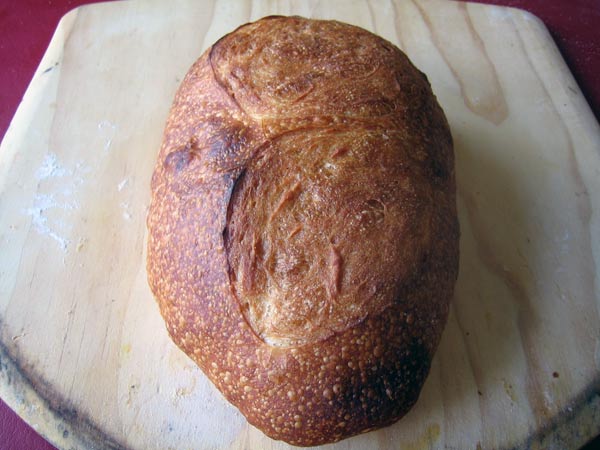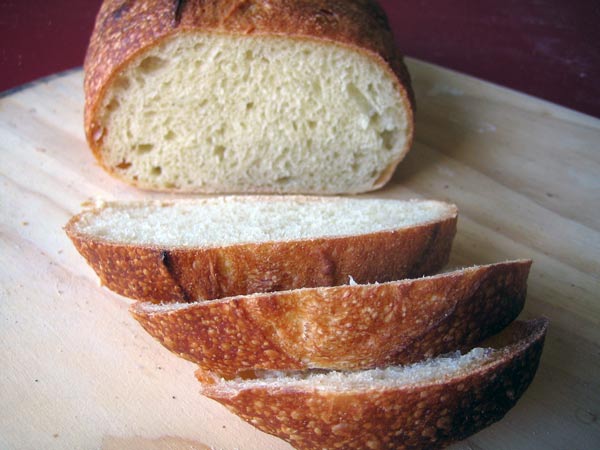
If you ever read my baker blog, you'll know that almost every week, regardless of what else I am baking, I bake a batch of pain sur poolish. I began baking a bread like this while reading The Village Baker. I've since adapted it to be even simpler.
This recipe really has become my control, my baseline for experimentation. Whether it be a new mixing technique, a new brand of flour, or a new baking schedule, when I apply a change to this recipe I have the easiest time perceiving how that change modified the outcome of my bread.
I'm offering up this recipe here because a few people have asked for it. But more than advocating this recipe in particular I'm advocating the method of finding something you like and using it as your baseline for experimentation.
My Pain Sur Poolish (Daily Bread)
Makes 2 loaves
Poolish
1 cup flour
1 cup water
1/4 teaspoon instant yeast
Final Dough
1 pound flour
10-12 ounces water
1 teaspoon instant yeast
2 teaspoons salt
all of the poolish
Combine the ingredients for the poolish in a small bowl the night before baking. Cover the bowl with plastic wrap and leave the poolish out at room temperature overnight.
The next day, prepare the final dough, either by using the autolyse method of flour and water first then the rest of the ingredients with minimal mixing or by combining them all and mixing until you have decent gluten development (8 to 10 minutes).
I typically fold the dough once an hour twice during primary fermentation, then shape the loaves and give them a longer final rise, typically around 90 minutes. Meanwhile, my oven and baking stone are preheating as hot as they can safely go.
Baking, with steam, takes me 20 minutes, 5 minutes or so at maximum oven temperature, the remainder at 450-475. I rotate the loaves once half way through the baking.

That is it. Simple, tasty, and a great recipe to practice with.
Relate Recipes: Italian Bread, Rustic Bread.
Do you have a bread recipe that is your standard? Please, share it!
Comments
Aha! Why didn't I read this whole thread before I tried this recipe? I thought I had screwed something up royally because I couldn't knead it in the smooth, masterful way I remember my grandmother did back when she made bread every day. Did I stop to think she was NOT making artisanal French bread? Nope. And so we learn from our mistakes.
Floyd, your tips, tricks, recipes and instructions are terrific. Thanks for all your hard work!
"I am not a cook. But I am sorta cooky."
how long can you leave a poolish sitting out before you use it an how long will it work?
I just tried something this week to work with the crust as it was coming out hard and thick for my boules - I saw a poster suggest spraying the loaves with waater and thn covering the bread for about 1/2 of the baking time with a work cover - I had to improvise and used a metal mixing bowl.
I've now tried this technique twice and I think I'm sold in terms of getting that thinner crunchy crust that I associate wiith bread..... Open to others jumpin in if any other ideas...
There are reasons that gas ovens are vented. Like... they need air in order to burn the gas. Like they need a way to get rid of the combustino gasses.
All in all.... like you said, don't blick the flippin' vents on a gas range. Electric is OK though.
Mike
I've never baked anything fancy that required something like a poolish. I did know about them though from a book that I gave to my mother-in-law, The Bread Bakers Apprentice. After seeing this recipe and finding other tips for the aspiring home baker of artisan/rustic breads I was inspired. Over the past weekend I made a loaf based on this recipe and it was fantastic.
Without a scale I had to guess the proper measurements of flour. Correct me if I'm wrong but would 1 lb. of flour come out to approximately 2-2/3 cups? Like other members who tried this recipe I too had to add more flour during the kneading process. Can someone offer a suggestion on how to properly add flour? I was adding 1/2 cup at a time and kneaded till the dough was tacky enough to peel away from the bowl without sticking to it. Anyway, below are a few pics on my results with the final being my set up in the oven.
In my oven I purchased six of these 6"x6" unglazed quarry tiles from Home Depot for about $3. I'm very happy with the results so I'll stick with them for now. As you can see I got a small cast iron skillet on the bottom of my oven for the steam part of my baking. Works like a charm.
Floyd:
Just wanted you to know that I've been working your daily bread recipe for the last couple of weekends and am just loving it. I'm using a longer, cool ferment, and I'm shaping more like un-scored baguettes, but in all other ways I'm staying faithful to your recipe.
It's frankly given me the crumb I've always hoped for: lots of air and very elastic, with a great crust.
Will put up a pic later today, if I can get my butt in gear.
Thanks a bunch!
Prandium longa. Vita brevis.
oolewisoo,
Assuming that your measurements of flour and liquid are correct, here are some things that can help your bread stand up:
1. Autolyse - sounds dangerous, doesn't it? It's simply the practice of mixing most of the flour and all of the liquid in the recipe together, then letting it sit for 20-60 minutes. Then you can add in yeast or levain, and salt. The sitting time gives the liquid an opportunity to hydrate the gluten in the flour, which gives the dough more strength.
2. Adequate kneading - can be done by mixer or by hand. Whatever technique you use (machine mixing with a dough hook, hand kneading, stretch and fold, French fold, letter fold, other), the objective is to have the finished dough be smooth and elastic. Whole-grain doughs typically require more kneading than white-flour doughs to achieve full gluten development and their textures will be somewhat rougher. Doughs with high rye contents are another matter entirely.
3. Surface tension - After the dough has proofed and is ready for shaping, your shaping technique has two objectives. First, to achieve the shape you want for the finished bread. Second, to develop enough surface tension in the skin of the loaf to help support it during the final proof and bake. Most shaping techniques involve stretching the top and side surfaces of the dough down and tucking them underneath. Note that super-wet doughs, like ciabatta, don't follow the same rules for shaping.
4. Support - while proofing, that is. You can use brotforms (willow or plastic baskets), bannetons (also baskets, sometimes with cloth liners), couches (can be made of linen, or cotton, or even a non-terry dish towel, or bakers parchment). the brotforms, bannetons, or cloth couches are usually heavily floured so that the dough does not stick to them.
That's the Readers Digest version. You can find a lot more detailed material here about the topic by using the search box that is located in the upper left corner of each page. There are also a number of videos that have been posted here which demonstrate the techniques.
Paul
I'm new to the fresh loaf site and this is my first try at bread with a preferment. I appreciate the wealth of info I've learned so far and the knowledge shared here gave me the confidence to try 'My Daily Bread'.
I'm at the point of my fourth folding. The dough seemed quite wet at first but now it can be handled. I've got some pretty huge bubbles through out the dough, some as large as golf balls, Should I make sure to break them while I'm folding or be carefull not too? A newbie question! Thanks for the help.
Somewhere in the middle: you want to be rough enough with the dough that you get good tightness on the surface, but soft enough that you leave many of the holes in it. It's a tough to nail it just right.
Good luck!
Thank you for the good advice Floyd ... and great recipe. I'm very pleased by this attempt. I've got lots to learn and looking forward to it.
This magic loaf came out of the oven at 5PM. At 530 we received a call that our first granddaughter was born. So we broke some bread in celebration. How sweet it is!
Looks really good, and congratulations!
This loaf look just right! Congratulations with family addition!
how many cups of flour and water would this be? I would really like to make this bread!
can someone please let me know what these measurements are in cups? I've not a scale, and am clueless when it comes to baking with grams.
Welcome. The recipe is at the top of the page. Cups are so variable but 8 fl oz is a cup. There are 16 dry oz in a pound. Fluid oz and dry oz are not the same. Reading the discussion should give you an idea what 1 pound of flour should be... somewhere between 2 1/2 to 3 cups depending on the flour.
Mini
thank you! I appreciate it. I think i can figure it out from here.
I just finished baking a loaf of this, and it turned out MAGNIFICENT! I don't think I've ever had better bread! Thank you for the recipe.
-TeaIV
Sorry for the silly question, but in a recipe like this (and typically) when an amount of a liquid is noted in ounces, is that liquid volume or by weight?
I weight all dry ingredients, but I'm never sure if I should be measure weights of liquid or volume.
Thanks.
When it comes to water, liquid volume and weight are the same ("a pint is a pound the world around", as my grandmother used to say). As for other liquids, I would take a cue from the other measurements. For example, if the dry ingredients are given in pounds and ounces, it's safe to assume the liquid ingredients are, too.
so a cup of water (8 fluid oz.) should be also 8 regular ounces?
8 oz = 8 oz...always...
Betty